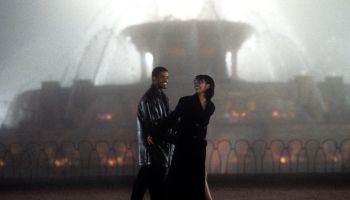New Documentary Set To Explore The ‘Real Story’ Behind The Green Book
Following “Green Book’s” epic night at the Oscars, where it won best picture and best supporting actor, comes news that an upcoming documentary will explore the historic travel guide that helped Black motorists safely navigate through the racist south.
In the film, 2x Oscar winner Mahershala Ali plays African-American pianist Don Shirley, who embarks on a tour of the deep south with driver Tony Vallelonga (Viggo Mortensen). The record label reportedly gave the driver a copy of the Green Book but the movie never clearly explores what the book is.
The new documentary, “The Green Book: Guide to Freedom,” will reportedly fill in the gaps.
Directed by Yoruba Richen, the film details how the real-life Green Book allowed Black travelers to safely navigate segregated America in the mid-1900s. In a recent interview, Richen explained the history of the Green Book, which “was a travel guide for African-Americans that was published from 1936 to 1967,” per krtv.com.
Read Richen’s Q&A with vox.com contributor P.R. Lockhart below (via msn.com).
P.R. Lockhart
When we spoke last year, you were promoting your short film on the black anti-abortion movement in the US. What led you to work on a documentary about the Green Book as your next project?
Yoruba Richen
Back in 2017, a production company based in London called Impossible Factual reached out with the idea of doing a film about the Green Book. I had never heard of the Green Book before we started talking, but I was immediately interested and intrigued. I thought I knew my African-American history, but I hadn’t heard this part of it. [Doing a project on the Green Book] seemed to be such a good way to tell different themes and stories that we don’t often get to see when we talk about the black experience.
P.R. Lockhart
When the documentary opens, it walks us through how, from the 1930s onward, the spread of cars and the fact that Americans began to have more disposable income made road trips and extensive travel across the US possible. But the film also shows that truly uninhibited travel was something that only white people were able to access until the Green Book was introduced and helped open up leisure travel to African Americans. Can you talk about the story behind the Green Book’s creation, you know, when and why it happened?
Yoruba Richen
The Green Book was first published in 1936 by Victor Green. He was a postal worker, and he has a Jewish friend who had a book that listed places in the Catskills where Jewish people could go to. And Green says, “This would be great for black people — we need a book like this.”
Green also had a wife who had family in Virginia. And they would travel down to Virginia, so he had that experience of “traveling while black” and what it entailed. That’s why he created the Green Book; he saw a need and then decided to fulfill that need.
P.R. Lockhart
What type of information was included in the Green Book?
Yoruba Richen
When the Green Book is first published, it is just listings in New York (where Green lived), but it quickly spreads all over the country and internationally. It has listings for everything from where black people can stay — hotels, motels, things called tourist homes where people opened up their houses to travelers. It has restaurants, barbershops, gas stations, clubs, liquor stores. And then it has places where we could go and vacation, recreation spots. Starting in the early 1940s, the book is called The Negro Motorist’s Guide to Travel and Vacations, and that’s a big part of what the book was providing.
P.R. Lockhart
One of the things that really sticks out in some recent depictions of the Green Book, namely in the Oscar-nominated film named after Victor Green’s guide, is this very persistent framing that racism against black Americans was concentrated in the Deep South. Your film notes that the Green Book was helpful for travelers all over the country. Can you talk about how the Green Book is really a national resource instead of a Southern one?
Yoruba Richen
I think the first step is really making sure that we talk about it as a national thing. I recently saw the fiction film, and you only see them use the Green Book in the South, and that perpetuates the mythology that racism and segregation is just in the South, and obviously, it is all over. It was a national issue.
In fact, in terms of navigation, it was much harder to navigate in the North and the West because you didn’t have the signs. You didn’t know what places were dangerous and what places you weren’t supposed to go into. So I think the first thing is acknowledging it as a national guide.
When Green started the Green Book, he lived in New York, in Harlem. And in the 1930s, there were places that African Americans were not allowed to go into. And from the research people have done on the Green Book, it was used in myriad ways, from finding a place to stay to finding places where people could go and have fun. The Great Migration is all through this time period, and there are black people who moved to the North who talk about using the Green Book when they went back to visit relatives in the South.
Richen said her film will show viewers how the Green Book helped African Americans go on vacation and enjoy a dignified life despite the personal safety risks at the time.
“I hope that they will really understand what it was like for African-Americans to travel the road of a segregated, racist society,” she said. “Despite that, African-Americans pursued recreation and pleasure and created a community.”
















